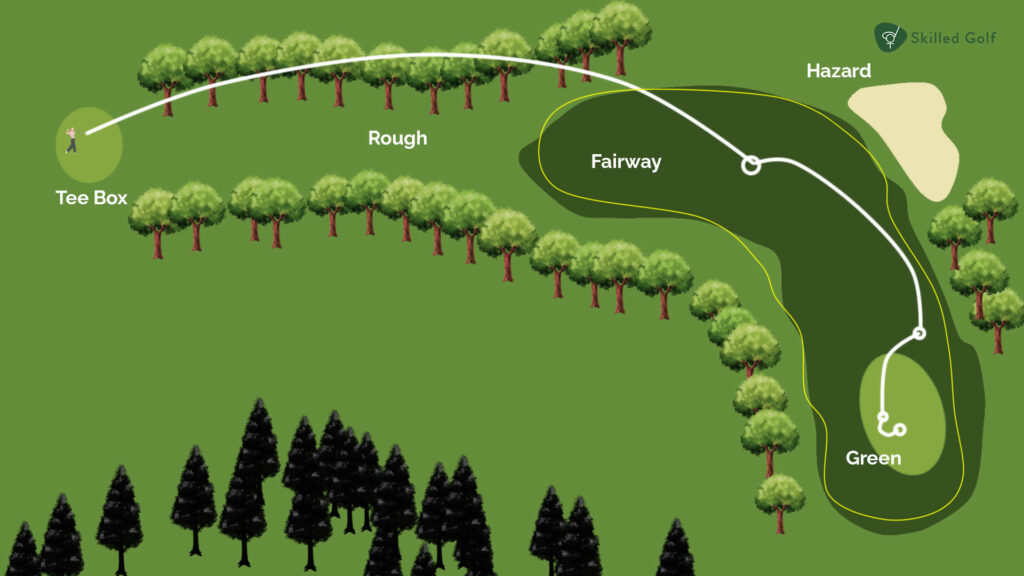Gaining a comprehensive understanding of the golf course is crucial for golfers aiming to enhance their skills and derive maximum satisfaction from the sport. A golf course is far more than a collection of holes; it is a meticulously planned and properly arranged setting that offers distinctive obstacles and advantages.
Through an understanding of the course’s design, golfers can formulate effective strategies, make informed choices, and ultimately elevate their overall performance. Let’s explore several key facets of comprehending the golf course, cover elements such as course design and layout, hole analysis, course management, and the importance of possessing this knowledge.
Course Design and Layout
Planning and arrangement of a golf course takes into consideration various factors such as, natural features, strategic challenges, and aesthetic appeal. It involves the careful placement of tees, fairways, bunkers, water hazards, and greens to create an engaging and challenging playing experience for golfers of different skill levels.
The design process requires a balance between playability, shot variety, and the preservation of the natural landscape. A well-designed course should offer strategic options, reward good shots, and provide an enjoyable and memorable golfing experience for players.

The Role of the Golf Course Architect
The involvement of a golf course architect is crucial in determining the design and arrangement of a golf course. Their primary responsibility is to visualize and construct a course that offers an enjoyable and stimulating experience for golfers.
In conceptualizing the course design, the architect takes into account factors like gameplay dynamics, visual appeal, and sustainable practices. Collaboration with experts such as landscape architects, engineers, and agronomists is essential to bring their vision to life and ensure the seamless execution of the design.
The Impact of Course Design on Gameplay and Aesthetics
The design of a golf course significantly influences the playing experience for golfers. The strategic positioning of hazards, bunkers, and water features serves to challenge players and assess their abilities. The architect meticulously considers factors such as hole length, difficulty, and the overall arrangement of the course to ensure a balanced and seamless flow.
Moreover, the aesthetics of the course are given careful thought, aiming to create a visually pleasing setting that blends harmoniously with the natural surroundings.
Factors Influencing Course Design
The design of a golf course is influenced by various factors. The land’s topography and natural characteristics are important in determining the course’s layout and routing. Hills, valleys, and water features can be strategically incorporated to provide diversity and excitement. Climate and weather conditions also play a role, as wind patterns and precipitation affect the orientation of holes and the choice of grass species.
Environmental considerations have gained significance in golf course design. Architects strive to protect and safeguard the natural surroundings by considering factors like water preservation, the maintenance of wildlife habitats, and the utilization of sustainable materials. Moreover, they take into account the proficiency of the intended players and the desired audience to achieve a suitable blend of challenge and enjoyment.
Understanding the Layout of a Golf Course

The arrangement and sequencing of holes are carefully planned to create a logical and engaging layout. The architect considers the flow of the course, ensuring that players can move efficiently from one hole to another. Golf courses provide various hole types, such as par 3, par 4, and par 5, each offering unique obstacles and chances that cater to golfers with different skill levels.
The design of the course is meticulously organized, taking into account factors like the terrain’s shape, natural characteristics, and safety measures. This determines the specific path that players will follow throughout the course, ensuring an enjoyable and safe playing experience. The strategic placement of hazards, such as bunkers and water hazards, tests golfers’ shot-making abilities and decision-making skills. These elements are strategically positioned to reward well-executed shots and add excitement to the gameplay experience.
Hole Analysis
The anatomy features various elements that contribute to the overall design and strategic challenges of the course:
Tee box: The starting point of a hole, where golfers tee off to begin their play.
Fairway: The manicured, well-maintained strip of grass that leads from the tee box to the green. It provides a clear path for golfers to progress toward the hole.
Rough: The areas surrounding the fairway typically consist of longer grass or thicker vegetation. The rough errant shots require more skill and precision to navigate.
Hazards: These include bunkers (sand traps) and water hazards (such as ponds or streams). Hazards are strategically placed to add challenge and strategic decision-making to the hole. They require golfers to carefully plan their shots to avoid penalties.
Greens: The final destination of each hole, where the flagstick and hole are located. Greens are typically shorter and more finely groomed than the fairways, providing a smooth surface for putting.
Contours: Greens are often designed with slopes and undulations. These contours add complexity and challenge to putting, as golfers must read the breaks and adjust their aim accordingly.
Bunkers and Water Hazards: Bunkers and water hazards are strategically positioned to require golfers to navigate them or play around them. They add risk and reward elements to the hole, requiring strategic decision-making.
Doglegs and Other Design Features: Some holes feature doglegs, where the fairway curves to the left or right. These design features add variety and strategic interest, forcing golfers to consider shot placement and strategy.

Strategies and Challenges for Each Hole Component
Effective tee shot placement and club selection: Golfers must carefully assess the hole’s layout, including the position of hazards and the desired landing area. Choosing the appropriate club and executing a well-placed tee shot can set up a favorable approach to the green.
Navigating fairway obstacles and hazards: As golfers progress along the fairway, they encounter obstacles such as bunkers, water hazards, or thick rough. Strategic decision-making is required to either avoid or strategically play around these hazards to maintain a good position for the next shot.
Approaching the green and evaluating pin placement: The approach shot to the green demands accuracy and distance control. Golfers must consider the pin placement, which affects the ideal landing spot on the green. Evaluating the pin location helps determine the est angle of attack and minimizes the risk of three-putting.
Reading and adapting to green contours: Green contours influence the break and speed of putts. Golfers need to carefully read and assess the slopes and undulations to gauge how the ball will roll. Adapting to the green’s topography is crucial for accurate putting and reducing the number of strokes on the green.
Evaluating Hole Difficulty
Factors influencing the difficulty of a hole: The length of the hole, presence of hazards, green complexity, wind conditions, and overall design contribute to a hole’s difficulty. The strategic demands and shot requirements also play a role in assessing its challenge level.
The role of course rating and slope rating: Course rating evaluates the difficulty for a scratch golfer, while slope rating measures the challenge for an average golfer. These ratings help determine a player’s handicap and provide a standardized way to compare courses.
Adjusting strategy based on hole difficulty: Challenging holes may require a more conservative approach, while easier holes can present opportunities for aggressive play. Adapting the game plan based on the difficulty of each hole is crucial for optimizing performance.
The impact of personal skill level on hole assessment: Individual skill level influences how a golfer perceives and tackles the challenges presented by a hole. A hole that poses minimal difficulty for an experienced player may be more demanding for a beginner. Understanding personal strengths and weaknesses helps golfers assess the difficulty level and make informed strategic decisions.
Course Management
Course management involves developing a game plan and adjusting strategies to maximize performance on the golf course. Here are some key aspects of effective course management:
Developing a Game Plan for the Course
1. Preparing for a round through course knowledge: Prior to the round, gather information about the course layout, yardages, hazards, and green complexes. Study course maps, yardage guides, and any available course-specific information to familiarize yourself with the layout.
2. Identifying strengths and weaknesses of the course: Assess the course’s design elements, such as hole layouts, hazards, and green complexes, to identify areas where you can leverage your strengths and potential challenges you may face.
3. Setting realistic goals and expectations: Evaluate your skill level and set achievable goals for the round. Consider factors such as course difficulty, current form, and any specific objectives you may have for the round.
4. Developing an overall strategy for success: Based on course knowledge, strengths, and goals, create a game plan that includes target areas for tee shots, approaches to the green, and strategies for managing hazards. This strategy should help navigate the course efficiently and make smart decisions.
Analyzing the Course’s Strengths and Weaknesses
1. Identifying favorable and challenging holes: Assess each hole’s characteristics, including length, hazards, and scoring potential. Recognize which holes suit the game and might face challenges.
2. Recognizing patterns and tendencies of the course: Pay attention to recurring themes or patterns in the course design, such as doglegs, prevailing winds, or challenging green complexes. This understanding helps anticipate and adapt to the course’s demands.
3. Adjusting game plan based on personal strengths and weaknesses: have a strategy to play through strengths and mitigate weaknesses. For example, if have a strong short game, focus on positioning yourself for easier up-and-down opportunities around the greens.
4. Applying knowledge of the course for scoring opportunities: Use familiarity with the course to identify scoring chances. Recognize holes where you typically perform well and capitalize on those opportunities to gain strokes.
Adjusting Strategy Based on Course Conditions and Personal Skill Level
1. Adapting to varying weather conditions: Account for factors such as wind direction and speed, temperature, and precipitation. Adjust your club selection, shot shape, and strategy accordingly to account for the weather’s impact on ball flight and course conditions.
2. Assessing the impact of course maintenance and setup: Consider how factors like rough length, green speed, and pin placements affect your strategy. Adapting your approach based on the condition and setup of the course during your round.
3. Having a strategy to fit the personal skill level and playing style: Adjust the game plan to suit strengths, weaknesses, and playing styles. For example, if you are struggling with long irons, prioritize accuracy off the tee to leave yourself with shorter approach shots.
4. Making strategic decisions during the round based on changing circumstances: Remain flexible and make adjustments as necessary during the round. Assess the current situation, such as your performance, course conditions, and changing circumstances, to make informed decisions that optimize your chances of success.
Conclusion
Golfers greatly benefit from a deep perception of the golf course, as it enables them to make knowledgeable choices, create successful tactics, and handle the obstacles presented by each hole. Recognizing the careful consideration and strategic planning invested in course design, as well as evaluating individuals and skillfully managing their approach, golfers can enhance their overall enjoyment and improve their on-course performance.

